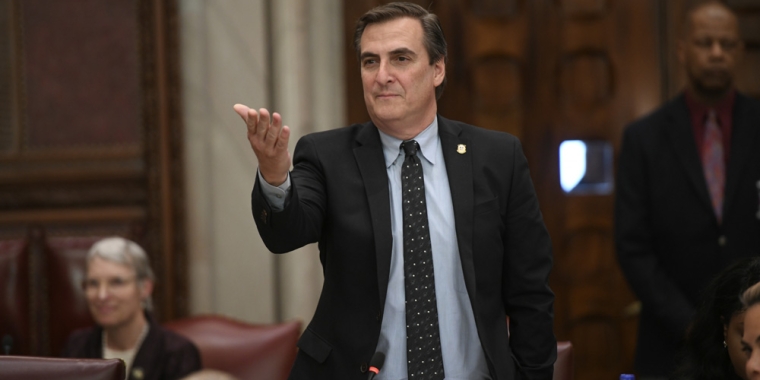
Politico New York: Obscure 1894 math crucial to New York politics is endangered

ALBANY — The general trend in American state legislatures has been toward downsizing, with the number of members increasing in only one of the country’s 99 chambers since the early 1980s.
Yet that outlier has increased its membership with some regularity: The New York State Senate went from 57 to 60 members in 1972, up to 61 in 1982, 62 in 2002, and 63 in 2012. It’s become a decennial tradition in Albany for Senate Republicans to announce in the final weeks of the redistricting process that they’ve discovered they can adjust the size of the Senate, and then they squeeze in a new district that coincidentally happens to benefit their political interests.
But after being burned by this practice in recent decades, Senate Democrats — who have the upper hand in the mapmaking process for the first time in generations — are pledging that they won’t follow suit.
The current majority also is looking to guarantee that the size of the Senate won’t change ever again. A Democratic-friendly constitutional amendment on redistricting that will be voted on this November includes language to permanently set the size of the chamber at 63 members.
“Setting the size of the Senate at a fixed number would eliminate one of the gerrymandering tools that Republicans have used in the past,” said Deputy Majority Leader Michael Gianaris (D-Queens). “There’s no reason to open the door to those kinds of shenanigans.”
The state constitution says that “the senate shall always be comprised of fifty members, except that if any county having three or more senators at the time of any apportionment shall be entitled on such ratio to an additional senator or senators, such additional senator or senators shall be given to such county in addition to the fifty senators, and the whole number of senators shall be increased to that extent.”
What in the world does that mean? In short, the courts have found, this confusing and dated section of the constitution can mean pretty much whatever people who have the votes to control redistricting want it to mean.
This language was authored in 1894 in an attempt to reduce the chances that those deemed unsavory — particularly Irishmen — would be able to take over Albany as they increasingly filled the voter rolls of downstate urban areas.
It was effectively designed as a circuit breaker at a time when districts were allocated as much by geography as by population. If Manhattan or Brooklyn got populous enough to justify that their delegation in the Senate increased beyond three members, they wouldn’t gobble up a district from some other county. A new district would be created, slowing the rate at which the overall percentage of Senate seats held by members from these counties could increase.
The federal government forced New York to change the way it distributed seats across the state following the move toward one person, one vote in the 1960s. But the language about the size of the Senate remained on the books, and officials eventually reached a general agreement on how it should be applied:
— Take the population of the state and divide by 50.
— Divide the population of each county by the number obtained above.
— For each county in which the number obtained in the previous line was greater than 3.0, subtract from that number the total number of Senate seats that the county had in 1894.
— Take every number obtained in the previous step that was greater than 0, round them down to the nearest whole number, then add them all up. Add 50 to this sum.
— If this new sum is bigger than the current size of the Senate, then congratulations, you can create some new districts!
There’s some good news for anybody who thinks that formula is simply too boring and straightforward — it actually gets a whole lot more complicated when applied in reality.
That’s because the county lines these days aren’t the same as they were in 1894. So when applying the formula, one can treat Queens and Nassau as the same county, as they were before the western portion of Nassau broke off to join New York City in 1898.
Also, Suffolk County and Staten Island were part of the same Senate district 127 years ago. Those can thus be treated as the same county as well.
It gets really fun when dealing with the borough that contains the Bronx River. The lands to the west of that body of water were once part of Manhattan, while the eastern banks were in Westchester. So for the purposes of applying the above math, one can choose between treating the Bronx and Manhattan as one county or simply combining the Bronx, Manhattan, and Westchester into one megacounty.
Senate Republicans came up with a new way of running the numbers in 2002. They divided the Bronx along the river, adding some of its residents to Westchester’s totals and the rest to Manhattan’s.
That let them run the numbers in a way that justified an increase in the size of the Senate from 61 to 62 members. And 62, “just entirely coincidentally, happened to be the number their technician had recommended to be the most useful to their designs,” said Todd Breitbart, who directed Senate Democrats’ staff work on redistricting at the time.
That increase meant that the average population of each district was reduced. The use of smaller districts made it easier to center seats around the last remaining Republican strongholds in New York City without having to worry about grouping them with too many Democratic neighborhoods. And an increase of only one seat was clearly better than going to 63 members — an internal GOP memo argued that this could force the creation of a “politically undesirable” district that combined “all the minority areas from Elmont … to Brentwood” on Long Island, and this “almost certainly would not be a Republican pickup.”
Republicans acknowledged that they had a lot of flexibility in determining how big the Senate would be.
“We think we could go to 62, 63, even 68,” Dean Skelos, then the Senate GOP’s chief redistricter, said at the time. “If you had two accountants and two mathematicians in the room, they would come up with four different answers.”
A decade later, all of the math that had been used in past decades seemed to guarantee the size would remain at 62. But with weeks to go until the lines needed to be finalized, the GOP introduced a new curve ball.
“They arrived at 63 districts by deciding that what had been in 1894 the 1st Senate District — the Suffolk-Richmond district — should be treated differently from the 2nd Senate District, which was the Queens-Nassau district,” Breitbart said.
Essentially, when running the formula mentioned above, Republicans used a different method of rounding for one of these districts than they did for the other, letting them produce two sets of numbers obtained through different methodologies. When these were combined, they were able to create a new district from Rotterdam to Kingston that was designed with the sole purpose of creating a path for then-Assemblymember George Amedore to join the Senate.
The courts, as they had in the past, let this new math slide.
“[T]he Court of Appeals [previously] recognized that the Legislature must be given ‘some flexibility in working out the opaque intricacies of the constitutional formula for readjusting the size of the Senate,’” a judge wrote in 2012. “Although this court finds disturbing the Legislature's use of one method for Queens and Nassau Counties and a different method for Richmond and Suffolk Counties, petitioners have not sustained their heavy burden of demonstrating beyond a reasonable doubt that the Legislature has acted unconstitutionally.”
So where does that leave things for this decade? Running the version of the formula that’s been supported by Democrats in court filings of yesteryear suggests that even if the amendment isn’t approved in November, the Senate should stay at 63 members.
Of course, the examples of recent decades do indicate that Democrats would have “some flexibility” to develop new math if they choose. But Gianaris, for his part, is pledging that won’t happen.
“We have no interest,” he said. “We’re trying to move away from that, not embrace it.”


